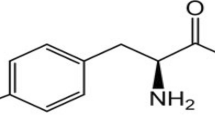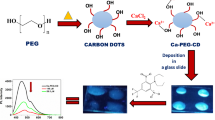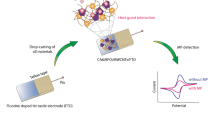Abstract
We describe a sensitive photoelectrochemical (PEC) sensor for the determination of the herbicide clethodim. The PEC sensor was constructed by using amino-MIL-125/TiO2 (MIL stands for Materials from Institute Lavoisier), an amino-functionalized metal-organic framework (MOF) modified with TiO2. The amino-MIL-125/TiO2 was synthesized by a simple one-step solvothermal method and placed on a glassy carbon electrode where it displays photoelectrocatalytic activity. Scanning electron microscopy (SEM), Fourier-transform infrared (FTIR) spectroscopy and X-ray diffractometry (XRD) were used to characterize the amino-MIL-125/TiO2. In the sensing process, amino-MIL-125/TiO2 is illuminated by visible light to produce electrons. These excited electrons are delivered to the glassy carbon electrode, leaving positively charged holes (h+) on the surface of the amino-MIL-125/TiO2. The holes react with H2O to generate hydroxy radicals (•OH). Clethodim rapidly attacks the hydroxy radicals and improves the efficiency of charge separation, this leading to an enhanced photocurrent. Under the optimal experimental conditions, this photoelectrochemical method enables clethodim to be quantified in the concentration range from 0.2 to 25 μmol L−1, with a detection limit (3 S/N) of 10 nmol L−1. The assay was applied to the determination of clethodim in soil samples, and results were in acceptable agreement with data obtained by liquid chromatography/mass spectrometry.

An amino-functionalized metal-organic framework (MOF) modified with titanium dioxide was synthesized and used as a new platform for photoelectrochemical sensing of the herbicide clethodim.







Similar content being viewed by others
References
Konstantinou IK, Albanis TA (2006) The status of pesticide pollution in surface waters (rivers and lakes) of Greece. Part I. Review on occurrence and levels. Environ Pollut 141:555
Rebich RA, Coupe RH, Thurman EM (2004) Herbicide concentrations in the Mississippi River Basin-the importance of chloroacetanilide herbicide degradates. Sci Total Environ 321:189
Marin JM, Sancho JV, Pozo OJ, Lopez FJ, Hernandez F (2006) Quantification and confirmation of anionic, cationic and neutral pesticides and transformation products in water by on-line solid phase extraction-liquid chromatography-tandem mass spectrometry. J Chromatogr A 1133:204
Yang Y, Gao S, Zhang Z, Lin C, Ma H, Li M (2005) Utilization technology for the herbicide clethodim. Chin J Pestic 44:186
Goodman CD, Mollard V, Louie T, Holloway GA, Watson KG, McFadden GI (2014) Apicoplast acetyl Co-A carboxylase of the human malaria parasite is not targeted by cyclohexanedione herbicides. Int J Parasitol 44:285
Ishimitsu S, Kaihara A, Yoshii K, Tsumura Y, Nakamura Y, Tonogai Y (2001) Determination of clethodim and its oxidation metabolites in crops by liquid chromatography with confirmation by LC/MS. J AOAC Int 84:1172
You XW, Liang L, Liu FM (2014) Dissipation and residues of clethodim and its oxidation metabolites in a rape-field ecosystem using QuEChERS and liquid chromatography/tandem mass spectrometry. Food Chem 143:170
Wang GL, Xu JJ, Chen HY, Fu SZ (2009) Label-free photoelectrochemical immunoassay for alpha-fetoprotein detection based on TiO2/CdS hybrid. Biosens Bioelectron 25:791
Tu WW, Dong YT, Lei JP, Ju HX (2010) Low-potential photoelectrochemical biosensing using porphyrin-functionalized TiO2 nanoparticles. Anal Chem 82:8711
Zhao WW, Xu JJ, Chen HY (2014) Photoelectrochemical DNA biosensors. Chem Rev 114:7421
Zhao WW, Xu JJ, Chen HY (2015) Photoelectrochemical bioanalysis: the state of the art. Chem Soc Rev 44:729
Kumar SG, Devi LG (2011) Review on modified TiO2 photocatalysis under UV/Visible light: selected results and related mechanisms on interfacial charge carrier transfer dynamics. J Phys Chem A 115:13211
Wang PH, Yap PS, Lim TT (2011) C-N-S tridoped TiO2 for photocatalytic degradation of tetracycline under visible-light irradiation. Appl Catal A Gen 39:252
Li H, Eddaoudi M, O’Keeffe M, Yaghi OM (1999) Design and synthesis of an exceptionally stable and highly porous metal-organic framework. Nature 402:276
Wang Y, Xie J, Wu YC, Hu XY (2014) A magnetic metal-organic framework as a new sorbent for solid-phase extraction of copper(II), and its determination by electrothermal AAS. Microchim Acta 181:949
Nasalevich MA, Goesten MG, Savenije TJ, Kapteijn F, Gascon J (2013) Enhancing optical absorption of metal-organic frameworks for improved visible light photocatalysis. Chem Commun 49:10575
Lei JP, Qian RC, Ling PH, Cui L, Ju HX (2014) Design and sensing applications of metal-organic framework composites. Trac Trends Anal Chem 58:71
Mueller U, Schubert M, Teich F, Puetter H, Schierle-Arndt K, Pastre J (2006) Metal-organic frameworks-prospective industrial applications. J Mater Chem 16:626
Hou CT, Peng JY, Xu Q, Ji ZP, Hu XY (2012) Elaborate fabrication of MOF-5 thin films on a glassy carbon electrode (GCE) for photoelectrochemical sensors. RSC Adv 2:12696
Zhan WW, Kuang Q, Zhou JZ, Kong XJ, Xie ZX, Zheng LS (2013) Semiconductor@metal-organic framework core-shell heterostructures: a case of ZnO@ZIF-8 nanorods with selective photoelectrochemical response. J Am Chem Soc 135:1926
Dan-Hardi M, Serre C, Frot T, Rozes L, Maurin G, Sanchez C, Ferey G (2009) A new photoactive crystalline highly porous titanium(IV) dicarboxylate. J Am Chem Soc 131:10857
Hendon CH, Tiana D, Fontecave M, Sanchez C, D’arras L, Sassoye C, Rozes L, Mellot-Draznieks C, Walsh A (2013) Engineering the optical response of the titanium-MIL-125 metal-organic framework through ligand functionalization. J Am Chem Soc 135:10942
Horiuchi Y, Toyao T, Saito M, Mochizuki K, Iwata M, Higashimura H, Anpo M, Matsuoka M (2012) Visible-light-promoted photocatalytic hydrogen production by using an amino-functionalized Ti(IV) metal-organic framework. J Phys Chem C 116:20848
de Miguel M, Ragon F, Devic T, Serre C, Horcajada P, Garcia H (2012) Evidence of photoinduced charge separation in the metal-organic framework MIL-125(Ti)-NH2. ChemPhysChem 13:3651
Sun DR, Ye L, Li ZH (2015) Visible-light-assisted aerobic photocatalytic oxidation of amines to imines over NH2-MIL-125(Ti). Appl Catal B Environ 164:428
Zlotea C, Phanon D, Mazaj M, Heurtaux D, Guillerm V, Serre C et al (2011) Effect of NH2 and CF3 functionalization on the hydrogen sorption properties of MOFs. Dalton Trans 40:4879
Xu Q, Wang YJ, Jin GD, Jin DQ, Li KX, Mao AR, Hu XY (2014) Photooxidation assisted sensitive detection of trace Mn2+ in tea by NH2-MIL-125 (Ti) modified carbon paste electrode. Sens Actuators B 201:274
Wang DS, Zhang J, Luo QZ, Li XY, Duan YD, An J (2009) Characterization and photocatalytic activity of poly (3-hexylthiophene)-modified TiO2 for degradation of methyl orange under visible light. Hazard Mater 169:546
Liang RW, Shen LJ, Jing FF, Wu WM, Qin N, Lin R, Wu L (2015) NH2-mediated indium metal–organic framework as a novel visible-light-driven photocatalyst for reduction of the aqueous Cr(VI). Appl Catal B Environ 162:245
Shen LJ, Liang SJ, Wu WM, Liang RW, Wu L (2013) Multifunctional NH2-mediated zirconium metal–organic framework as an efficient visible-light-driven photocatalyst for selective oxidation of alcohols and reduction of aqueous Cr(VI)+. Dalton Trans 42:13649
Fu YH, Sun DR, Chen YJ, Huang RK, Ding ZX, Fu XZ, Li ZH (2012) An amine-functionalized titanium metal–organic framework photocatalyst with visible-light-induced activity for CO2 reduction. Angew Chem Int Ed 51:3364
Tang JW, Durrant JR, Klug DR (2008) Mechanism of photocatalytic water splitting in TiO2. Reaction of water with photoholes, importance of charge carrier dynamics, and evidence for four-hole chemistry. J Am Chem Soc 130:13885
Kim SN, Kim J, Kim HY, Cho HY, Ahn WS (2014) Adsorption/ catalytic properties of MIL-125 and NH2-MIL-125. Catal Today 204:85
Liu HP, Xu GQ, Wang JW, Lv J, Zheng ZX, Wu YC (2014) Photoelectrochemical properties of TiO2 Nanotube Arrays Modified with BiOCl nanosheets. Electrochim Acta 130:213
Zhu W, Liu PJ, Xiao SN, Wang WC, Zhang DQ, Li HX (2015) Microwave-assisted synthesis of Ag-doped MOFs-like organotitanium polymer with high activity in visible-light driven photocatalytic NO oxidization. Appl Catal B Environ 172:46
Acknowledgments
We gratefully acknowledge the financial support from the National Natural Science Foundation of China (No. 21275124 and 21275125), PAPD of Jiangsu Higher Education Institutions, Qing Lan Project of Jiangsu Province (2014-23, 11KJB150019), China Senior Visiting Scholar Program Projects of Jiangsu Province Vocational Colleges (2014FX085), Graduate Innovation Project Foundation of Jiangsu province (KYLX_1333 and KYLX_1334), and The High-End Talent Project of Yangzhou University.
Author information
Authors and Affiliations
Corresponding author
Electronic supplementary material
Below is the link to the electronic supplementary material.
ESM 1
(DOCX 65.8 KB)
Rights and permissions
About this article
Cite this article
Jin, D., Xu, Q., Yu, L. et al. Photoelectrochemical detection of the herbicide clethodim by using the modified metal-organic framework amino-MIL-125(Ti)/TiO2 . Microchim Acta 182, 1885–1892 (2015). https://doi.org/10.1007/s00604-015-1505-9
Received:
Accepted:
Published:
Issue Date:
DOI: https://doi.org/10.1007/s00604-015-1505-9




